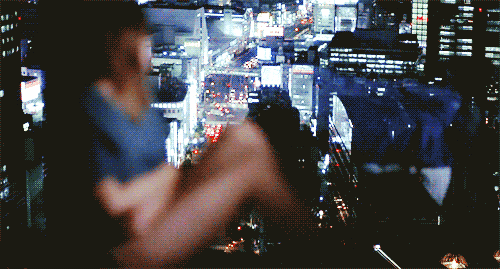When you first watch Lost in Translation, the thing that will strike you the most is the film’s melancholic colour palette. A tint of blue finds its way into nearly every frame, it also neatly encapsulates the entire mood of the film – a sadness you can feel but you don’t quite know why. Sofia Coppola’s 2003 directorial venture starring Bill Murray and Scarlett Johansson is a romance drama for the ages shot beautifully in Tokyo. It is both dizzyingly romantic and heartbreakingly sad; the atmosphere it creates will leave a permanent mark on your memory.
Bob (Bill Murray) is an ageing film-star, seemingly having the best of everything, yet somehow still discontent. Charlotte (Scarlett Johansson), fresh out of college is married to an airy photographer, she’s young and full of promise, but there’s sense of no direction within her she can’t contain. Bob is in Tokyo for the shoot of an ad commercial while Charlotte arrives in the Japanese capital accompanying her husband on a project. Left alone to explore the city as her husband is away on work, she meets Bob one evening in the hotel bar they’re both staying at.

How Bob and Charlotte’s relationship evolves
Their age difference is striking, her youthful arrogance in stark contrast with his ageing indifference to most things. They strike up a conversation and realise they have more in common than they realise. Foreigners in a strange new city, they decide to lean on each other for some companionship.
As audiences, we’re aware of the visible obstacle in their potential romantic relationship-they’re both married. Despite this, they’re drawn to each other and as . The sense of disenchantment they both feel with life, for different reasons, is what brings them together. The hustle and bustle of Tokyo is in glaring contrast to these timid, shy characters who find themselves consumed in the city lights, so overcome by a feeling of otherness that they’ve chosen to simply be passive about it.

Thematic elements in Lost in Translation
Coppola intersperses so much of the film with silences and with shots of Charlotte staring out of her hotel room window at the bustling city of Tokyo below. She steadily builds this sense of loneliness and alienation, the kind that comes with being a stranger in a big city, but more importantly when you feel like a stranger in your own life. Bob and Charlotte are unhappy in their marriages, they are unhappy with the people they’ve let themselves become. The few moments of respite they get from this existential angst, is the time they have together.
“Let’s never come here again because it will never be as much fun”, Charlotte tells Bob at one point in the film. This is essentially what Coppola wants to tell the audience- that sometimes we have these once in a lifetime experiences that we cannot recreate. Bob and Charlotte know that they are probably never going to see each other again, which makes the time they spend together so much more meaningful.

The city of Tokyo is dazzling; Bob and Charlotte take to the streets, exploring the city with each other. They go to bars, meet new people, and spend time with each other as a means of escape from the mundanity that consumes them. The way their relationship unfolds is heart-wrenchingly beautiful. They know that their feelings for each other are problematic, but they just cannot resist it.
Much like Richard Linklater’s Before Sunrise, Lost in Translation progresses through intimate conversations, where the characters unabashedly share details about their life they’re otherwise scared to confront. Murray and Johansson’s chemistry with each other is what makes everything all the more real and personal for these characters.

There are moments scattered throughout the film that speak volumes about what Bob and Charlotte have grown to mean to each in the short span of time they’ve spent together. The ending of the film is one of the most iconic scenes in contemporary cinema. These two people manage to mean something to each other despite their circumstances, reaffirming the fact that true connection is beyond banal societal constructs of what can and cannot be love.










